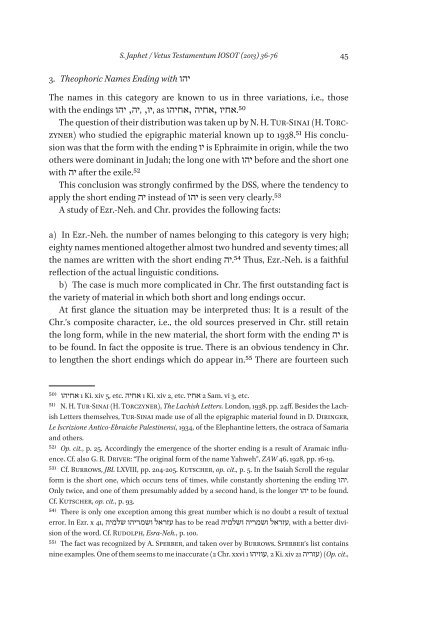Special Issue IOSOT 2013 - Books and Journals
Special Issue IOSOT 2013 - Books and Journals
Special Issue IOSOT 2013 - Books and Journals
You also want an ePaper? Increase the reach of your titles
YUMPU automatically turns print PDFs into web optimized ePapers that Google loves.
S. Japhet / Vetus Testamentum <strong>IOSOT</strong> (<strong>2013</strong>) 36-76 45<br />
יהו 3. Theophoric Names Ending with<br />
The names in this category are known to us in three variations, i.e., those<br />
50.אחיו ,אחיה ,אחיהו as ,יו, ,יה, יהו with the endings<br />
The question of their distribution was taken up by N. H. Tur-Sinai (H. Torczyner)<br />
who studied the epigraphic material known up to 1938.51 His conclusion<br />
was that the form with the ending יו is Ephraimite in origin, while the two<br />
others were dominant in Judah; the long one with יהו before <strong>and</strong> the short one<br />
with יה after the exile.52<br />
This conclusion was strongly confirmed by the DSS, where the tendency to<br />
apply the short ending יה instead of יהו is seen very clearly.53<br />
A study of Ezr.-Neh. <strong>and</strong> Chr. provides the following facts:<br />
a) In Ezr.-Neh. the number of names belonging to this category is very high;<br />
eighty names mentioned altogether almost two hundred <strong>and</strong> seventy times; all<br />
the names are written with the short ending 54.יה Thus, Ezr.-Neh. is a faithful<br />
reflection of the actual linguistic conditions.<br />
b) The case is much more complicated in Chr. The first outst<strong>and</strong>ing fact is<br />
the variety of material in which both short <strong>and</strong> long endings occur.<br />
At first glance the situation may be interpreted thus: It is a result of the<br />
Chr.’s composite character, i.e., the old sources preserved in Chr. still retain<br />
the long form, while in the new material, the short form with the ending יה is<br />
to be found. In fact the opposite is true. There is an obvious tendency in Chr.<br />
to lengthen the short endings which do appear in.55 There are fourteen such<br />
etc. 2 Sam. vi 3, אחיו etc. 1 Ki. xiv 2, אחיה etc. 1 Ki. xiv 5, אחיהו 50)<br />
51) N. H. Tur-Sinai (H. Torczyner), The Lachish Letters. London, 1938, pp. 24ff. Besides the Lachish<br />
Letters themselves, Tur-Sinai made use of all the epigraphic material found in D. Diringer,<br />
Le Iscrizione Antico-Ebraiche Palestinensi, 1934, of the Elephantine letters, the ostraca of Samaria<br />
<strong>and</strong> others.<br />
52) Op. cit., p. 25. Accordingly the emergence of the shorter ending is a result of Aramaic influence.<br />
Cf. also G. R. Driver: “The original form of the name Yahweh”, ZAW 46, 1928, pp. 16-19.<br />
53) Cf. Burrows, JBL LXVIII, pp. 204-205. Kutscher, op. cit., p. 5. In the Isaiah Scroll the regular<br />
.יהו form is the short one, which occurs tens of times, while constantly shortening the ending<br />
Only twice, <strong>and</strong> one of them presumably added by a second h<strong>and</strong>, is the longer יהו to be found.<br />
Cf. Kutscher, op. cit., p. 93.<br />
54) There is only one exception among this great number which is no doubt a result of textual<br />
error. In Ezr. x 41, עזראל ושמריהו שלמיה has to be read ושמריה ושלמיה ,עזראל with a better division<br />
of the word. Cf. Rudolph, Esra-Neh., p. 100.<br />
55) The fact was recognized by A. Sperber, <strong>and</strong> taken over by Burrows. Sperber’s list contains<br />
nine examples. One of them seems to me inaccurate (2 Chr. ,עוזיהו xxvi 1 2 Ki. xiv 21 (עזריה (Op. cit.,








![Am HaSefer [Volk des Buches] - Books and Journals](https://img.yumpu.com/20648352/1/174x260/am-hasefer-volk-des-buches-books-and-journals.jpg?quality=85)







